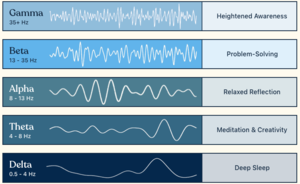Electroencephalography: Difference between revisions
(Created page with "'''Electroencephalography (EEG) is a technique used to record the electrical activity of the brain through electrodes placed on the scalp. These electrodes detect electrical impulses generated by the firing of neurons in the brain, which are then amplified and displayed as waveforms.''' EEG is widely used to study brain function, diagnose neurological disorders like epilepsy, monitor sleep, and in research on cognitive processes. The recorded brain activity reveals patte...") |
mNo edit summary |
||
| Line 2: | Line 2: | ||
=== Different Brain Wave States === | === Different Brain Wave States === | ||
[[File:Brainwave states.png|alt=Brainwave states|thumb|'''Figure 1'''. Brainwave states]] | |||
Brain waves are typically categorized into five main types based on their frequency, each correlating with different states of consciousness: | Brain waves are typically categorized into five main types based on their frequency, each correlating with different states of consciousness: | ||
Latest revision as of 02:39, 9 November 2024
Electroencephalography (EEG) is a technique used to record the electrical activity of the brain through electrodes placed on the scalp. These electrodes detect electrical impulses generated by the firing of neurons in the brain, which are then amplified and displayed as waveforms. EEG is widely used to study brain function, diagnose neurological disorders like epilepsy, monitor sleep, and in research on cognitive processes. The recorded brain activity reveals patterns or "brain waves," which are classified based on their frequency and are associated with various mental states and functions.
Different Brain Wave States
Brain waves are typically categorized into five main types based on their frequency, each correlating with different states of consciousness:
- Delta waves (0.5–4 Hz) are the slowest and are associated with deep, restorative sleep and unconscious states.
- Theta waves (4–8 Hz) are linked to light sleep, deep relaxation, and the dreamlike, creative states often found in meditation.
- Alpha waves (8–13 Hz) are seen during calm, relaxed, but alert states, such as when quietly resting or daydreaming.
- Beta waves (13–30 Hz) are faster and associated with active thinking, problem-solving, and focused attention; they dominate when we are awake and engaged.
- Gamma waves (30 Hz and above) are the fastest, often associated with high-level cognitive functioning, learning, and memory processing, and are observed during moments of peak mental activity and insight.
Each brain wave state plays a unique role in mental and physiological processes, shifting dynamically as our activity, attention, and levels of relaxation or stress change throughout the day.
